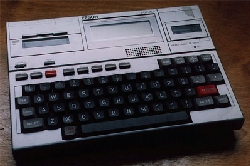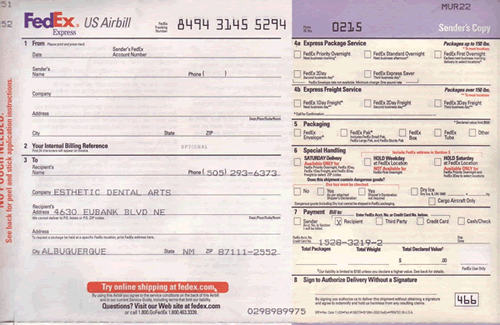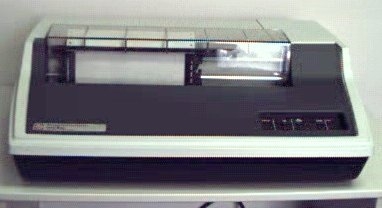Evolution:
The system above met the minimum needs of the volume customers. It was interesting that the printer cost more than the Apple II computer and monitor. It had to be rugged to print thousands of multi part airbills to go thru the carbon. Eventually a phone line was added and the system would dial FedEx and get updates on their shipments, when FedEx implemented COSMOS IIa which begin tracking packages In and Out of a station and the hub.. Package information became more and more important and was utilized for Billing. In the early 80's long distance was over $1.00 per minute.
Following the Apple II, a smaller device was deployed which utilized small cassettes. This device was built by Epson and was called the Epson Meter.

With this device, package information was collected on tapes and the tapes were shipped to FedEx to assist in billing.
Vector computers were used for a time also to replace the the Apple II computers.
NEC APC Era

When ZAPMAIL, FedEx's entry into Group IV facsimile was shut down, FedEx had obligations to NEC to purchase facismile equipment. NEC relayed to FedEx that they could purchase anything that NEC built, as long as the financial obligation was met.
Dennis Jones who was VP of Revenue raised his hand to use to expand to Customers as Automation devices.
Dennis Jones w/Laurie Tucker had increased the expansion of Automation devices to the point that 30% of the billing information was coming thrut he devices. With more units, they could increase the amount of electronic info into FedEx's network and improve access to customers.
FedEx took delivery of thousands of NEC APC computers. Under direction of Dennis Jones, these were deployed to FedEx's larger customers and the Automation program rapidly expanded. The program was later renamed FedEx Powership.
When IBM released the PC or personal computer, many more options became availble and the Powership program expanded to 100's of thousands of devices provided by FedEx or software placed on customers' own computers.
FedEx has always been innovative with automation. These system which began as just a system to print the airbills have become integral as a point of prescence for FedEx.
Tracking packages, providing billing and manifest information and integration of FedEx software into the customer's software are all provided by the automation programs.
Evolution of Automation
There were a few other developments worth mentioning in the evolution of Automation.
1. The Calculator Concept
A concept was developed to provide a proposed $100 calculator type device for Customer use.
This device would conceivably plug into a phone line. The customer could enter a time, and request an automatic dispatch of a courier; could order supplies, validate service to specific zipcodes and track a package shipment. This concept was developed in SIS(Strategic Integrated Systems) by VP Harry Dalton. It was initially called Cosmos IIIc and internally labelled the 'Sally B Device'; By the time the device was actually built it was a nifty device with above functions, but cost $800 each in small quantities. Personal computer costs had decreased from $2000 each to around $1100 which had disks and full functionality. It was dropped in favor of a less expensive PC.
2. Powership 3
Initially most of fedex shipments came from shipping docks or warehouses. Eventually many of the shipping decisions were made in the Front office by business people. A large Personal computer with a label printer and reports printer did not fit well on a persons desk, and they didn't want just a shipping computer on their desk. Dennis envisioned a smaller less funcitonal computer to be used by office professionals. It would be similar to the Minitel terminal that France had deployed as a white pages book.
I worked at the time for Winn Stephenson. Miley Ainsworth's group developed a graphics airbill type interface on a small 9" personal computer that Bruce Lindow had put together in Taiwan. In all over 10,000 of these devices were deployed. Because of increasing functionality requirements, eventually these $500 devices approached the cost of a full sized powership 2 device; plus since it was a dial only terminal, comm costs made it not economical.
3. Automated Drop Boxes
While not a Customer Premise device, there were prototypes of electronic drop boxes deployed in the early 80's.
These became a great source of packages as customers found them easy to just drop in a box close to their premises. In a few cases an innovative marketing person, licensed some of the drop boxes as 'hot dog stands' which allowed them to be moved around the city.
The initial prototypes included radio communications, a telephone for customer access, service and routing tables and cut off times for the last pickup from the drop box.
Software Development
The software on the Apple, Vector and Epson devices was in BASIC. In the early 80's I wrote some apps for the Apple for customers to have multiple shipping databases...although the floppy disks only had around 80,000 bytes of info.
Steve Stewart wrote much of the Epson Meter application while working for the vendor who sold the devices, and he later came to work at FedEx. Mike Struminger wrote much of the applications for the personal computers.
In the mid to late 80's Tom Schmidike who was the Director of the business side of Automation, hired Chuck Deiotte to teach the staff the 'C' programming language. After leaving FedEx, Chuck had formed his own consulting company. He flew into Memphis from Colorado Springs and taught programmers Lattice C.
Importance
The Automation program became more important as FedEx needed information before the packages were shipped, especially for International shipments. The FWS adage:
"Information about the package will become as important as the package itself"
became true as information was used for shipment planning, revenue documents, tracking and pickup and International customs clearance. And the more customers used Automation devices the less airbills there were to process for billing the the FedEx system. Hundreds of thousands of automation devices or software only units are deployed giving customers access into the FedEx system.
Internet Package Tracking
Under Winn and my management a group of employees led by Miley Ainsworth & Dale Browning came up with the following idea in the middle of the 90's: What can we do with the Internet besides just looking at documentation and USENET groups? They came up with the idea...how about Tracking FedEx packages. In a short timeframe they put up a webpage allowing users to track FedEx packages anywhere they had web access. No other special software was needed. This became a huge success, with many publications writing 'Finally, something that is useful on the Internet'.
With this one tracking webpage, FedEx marketing and IT development built an entire group of software services providing internet customers direct access to shipping, tracking and other services. Known as www.fedex.com
|





